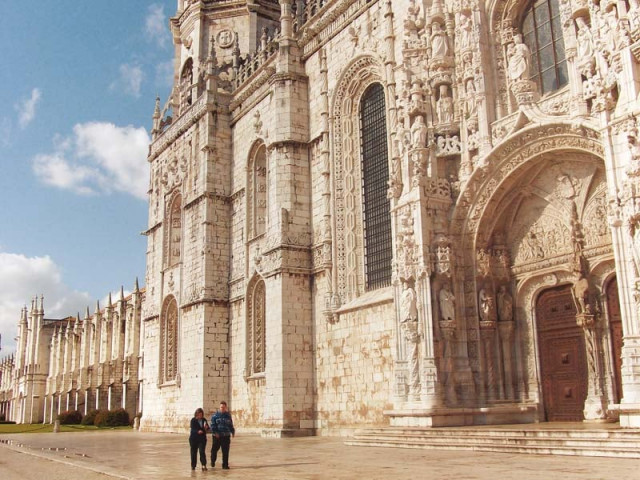Travel: The lure of Lisbon
The rustic and beautiful capital is the perfect place to start your journey through Portugal

The Jeronimos Monastery — Vasco da Gama’s final resting place. PHOTOS : AMNA YAMIN
There were many reasons why Portugal was my destination of choice. Perhaps, it was the effect reading the book Night Train to Lisbon had on me. It might also have been a postcard I received from an old Portuguese friend bearing the image of a ship in a vast ocean, with a message telling me to dream, explore and discover. My journey, I decided, should echo the footsteps of this country’s sons, whose voyages and conquests had led to the establishment of the great Portuguese empire — an empire whose influence was felt all across Asia, Africa and Latin America. In a small testament to the empire’s impact, Portuguese is still spoken in Goa (India), Macao (China), Angola and Brazil today.

The shore of River Tagus overlooks the 25th of April Bridge, the longest suspension bridge in the world outside the United States of America. PHOTO: ROBERTO MARTINS
Portugal claims to be the world’s oldest kingdom and my journey into its storied landscape began in the somewhat rustic but breathtakingly beautiful capital Lisbon, or Lisboa as it is called by locals. Here, my brown skin and dark hair did not stick out. On my drive to the hostel in the old district of Belem, the taxi driver chatted with me, pointing out all the shops on our journey that are run by South Asians. “I see more and more of your people here,” he remarked. “They come in hoards and stay.”
Lisbon is nothing like the other western European capitals I have been to. The people here are warm and friendly and the city, despite its thriving night life, manages to retain an old town feel. Perhaps this is due to the yellow trams that ply the streets, looking like they are straight out of a movie from the 1930s.

My hostel overlooked the ‘Tejo’ or the River Tagus. My first day in the city was warm enough for a stroll along the river, despite the fact that it was February. I was reminded of a friend’s comment that the Portuguese love the sea. Being situated at the western-most point of continental Europe, Portuguese have always been eager to explore the world beyond their borders. The water drove hordes of Portuguese men into its arms, luring them with promises of a better future, wealth and women.
On the northern bank of Tagus, I caught a glimpse of the explorer Vasco da Gama’’s voyages carved on the pavement. I was told by another tourist that locals refer to this spot as Calcada square. It serves as a reminder of a bygone era: Vasco da Gama may have been one of many sea explorers but his voyages eventually paved the way for the spice trade from India to Europe. Even as Portugal is a crumbling economy today, one can still see traces of a once-booming spice trade here on the streets of Lisbon through its tiled walls and coloured pavements.

The Padrão dos Descobrimentos is a reminder of the Portugese ‘Age of Discoveries’. PHOTO: AMNA YAMIN
A little further along the shore of the river lies the famed Padrão dos Descobrimentos or the Monument to Discoveries. Its location symbolises the point in the river where ships departed to explore and trade with India and the Orient. This 52-metre-high concrete monument was erected to celebrate the 500th death anniversary of Henry the Navigator and serves as a reminder of Portugal’s ‘Age of Exploration’ during the 15th and 16th centuries.

Across the street from the monument lies the Monastery of Jerónimos. This is perhaps Portugal’s most intriguing building. The monastery, built by King Manuel from ‘pepper money’ earned from a 5% tax on spices brought back from India, does not have a Moorish style, unlike many other ancient buildings in the country. According to legend, sailors prayed here before embarking on unpredictable voyages, while monks were charged with providing solace and comfort to these sailors. Today, this riverside church does not have a functioning monastery. The water has receded and so has the spirituality.
Inside the church, you can spot a painting by Leonardo da Vinci and visit the final resting place of Vasco da Gama. I was stunned to discover the burial spot here, as I expected the legendary explorer to be buried in Kochin, India, where he died. The famous Portuguese poet Fernando Pessoa is also buried at this site.
Later, I walked by the Tower of Belem, a symbol of voyages made by the powerful. It is said that in Portugal, the Torre de Belem was the last thing sailors saw when they left and the first sight when they returned to Portugal. It was originally planned to replicate at least 16 other Belem towers, but this never came to be.

Lisbon’s tram 28, one of many yellow-coloured trams across the city. PHOTO: ROBERTO MARTINS
As my first day wound to a close, I did not want to sleep without trying the famous Casa Pasteis de Belém. In other parts of the world, people refer to this wonderful cream tart as ‘pastel de nata’. Here, in its birthplace, it is known simply as ‘pastel de Belém’. As I complemented the tart with aromatic strong coffee, I knew for certain that beginning my Portuguese journey in Lisbon was the right decision.
Amna Yamin is a social entrepreneur who is on the path to discovering the world one city at a time. She tweets @AmnaYamin
Published in The Express Tribune, Sunday Magazine, May 10th, 2015.



















COMMENTS
Comments are moderated and generally will be posted if they are on-topic and not abusive.
For more information, please see our Comments FAQ